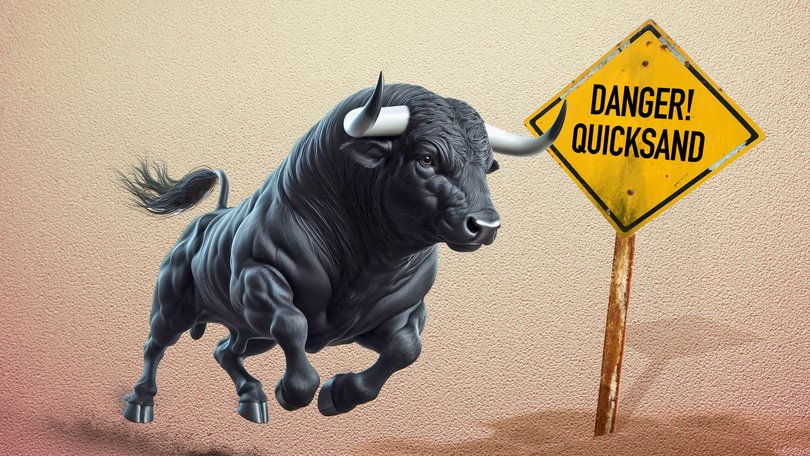ASX rollercoaster: After a major market melt-up, a reckoning looms

The Australian share market has been on something of a tear over the past few months, up 11 per cent since the depths of Donald Trump’s Kamikaze tariff attack, cresting at an all-time high Friday.
It’s an impressive run given the economy is barely limping along, interest rates are only ever so slightly on the way down and the global economy is on tenterhooks.
Such lofty heights amid persistent uncertainty suggest this bull run has more to do with FOMO than fundamentals and vis ulnerable to any hint of bad news.
Sign up to The Nightly's newsletters.
Get the first look at the digital newspaper, curated daily stories and breaking headlines delivered to your inbox.
By continuing you agree to our Terms and Privacy Policy.How else to explain a drop of as much as 2.9 per cent for our largest bank, CBA, 3.4 per cent nearly and 2.75 for ANZ and NAB?
The sell-off has been sheeted home to the Japanese election, where the ruling Liberal Democratic Party lost its majority in the upper house of parliament. It’s the first time there hasn’t been a governing majority since 1955. Market watchers suggest it could derail Japan’s economic trajectory, given its high debt levels.
That issue seems a long way from Australian banks, which derive the majority of their revenues from domestic lending.
Aussie banks were up 30 per cent for the financial year ended, driven by the 46 per cent gain for Commbank.
Australia’s largest bank has been seen as something of a safe haven in times of uncertainty, popular with domestic and international investors alike for its strong balance sheet and stable earnings.
But the company is not shooting the lights out in terms of growth, meaning investors are pushing up company valuations without worrying if it is being met by associated profits.
“CBA is the extreme version of that. On Friday, it was at record levels, and this is despite several years of falling earnings and significant uncertainty around what may happen internationally with tariffs,” said AMP chief economist Shane Oliver.
It might be that the FOMO trade is going elsewhere. While banks were sold, miners were gold, with Rio Tinto up 1.5 per cent, Fortescue 1.35 per cent and South 32 up 4.33 per cent.
There may also be a bet building on China. Stronger oil and metals prices in recent weeks have stirred speculation Beijing could unleash new stimulus. The iron ore price hit a four-month high thanks to a Chinese plan to build a hydroelectric dam in Tibet. But the base metal has been on the upward slope for four weeks, not due to further stimulus talks however, but a forced consolidation of the sector.
In a market that is on the hunt for good news, investors seem to be ready to bid on any opportunities.
“Maybe the market’s stepping that out,” Dr Oliver said, though he cautioned that recent Chinese GDP data didn’t support that optimism. “There was nothing in there suggesting China’s going to jump in with a big stimulus. I’m less optimistic than the market on that one.”
A higher iron ore price will certainly be welcome for miners, but a lot of the market is still relying on a bump from the Reserve Bank cutting interest rates.
While that will be positive for corporates, the market seems very confident.
Across the ASX200 the price earnings ratio - a metric that shows how much investors are willing to pay for each dollar of a company’s profit - is 23 times and well above the long term average of around 17.
It is also heading higher, raising questions about whether investors are shovelling money into stocks beyond the bargain hunting in the wake of Trump’s Liberation Day tariff announcement.
“Share markets aren’t cheap anymore,” Dr Oliver said. “Maybe they were back in April… but they’re not cheap anymore. Valuation measures certainly suggest the market is somewhat expensive.”
A similar story is playing out in the US, where the markets have hit new records.
That is significantly driven by the dominant tech firms but also in the hope that two key events occur: The US Federal Reserve cuts interest rates, and Trump backs down on tariffs.
US markets edged higher on suggestions by one Fed member that rates should be cut, even though Fed chair Powell has indicated no change until the tariff impact can be calculated.
The other big hope is the TACO trade. Investors are banking on Trump Always Chickening Out, presuming he will cave in the face of economic fallout.
It’s a risky strategy, given the still very punitive tariff levies spelled out in recent letters.
But the key indicator of market risk, the VIX measure of market volatility, is not much higher than before Trump came to office at 16.41.
In April, when tariffs were announced, it spiked above 52.
“That’s another indication of the extreme optimism around the TACO trade,” Dr Oliver said.
That sets up the current earnings season as a key test of investor confidence. Companies will need to show profit growth that justifies their expanded multiples or risk sharp repricing.
While investment firms are banking on those earnings staying benign, early signs suggest company insiders are already wary. According to data from InsiderSentiment.com, just 10 per cent of corporate officers are buying their own company’s stock. That is well below the 10-year average in the high 20s and far off the peaks above 40 per cent recorded in recent years.
It leaves investors with quite the dilemma. Sit the current enthusiasm out and miss out on the steady melt up or bank on a combination of factors all working in unison: a tariff climbdown, a Fed rate cut, a Chinese stimulus, and no other destabilising factors.
It’s heady stuff, and at these levels, markets can easily run out of oxygen.

